Home
> Scales
/ Theory
> Soloing
Over 7th Chords
Now
we're looking at step 3 - how to solo over 7th
chords. We'll be following exactly the
same process as before, but this time we need to identify if the
backing chord is a major 7th, dominant 7th or minor 7th chord type.
This will further determine which scales and scale tones we can use in
our solo.
The chord theory series looks at what 7th chords are made of, so it'll help to understand these building blocks, but I'll reference examples throughout this lesson.
Also, the more scales you learn, the better (see the scales section), because you'll know exactly which type of 7th each scale uses. Again, I'll reference examples.
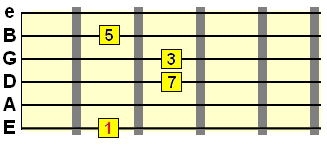
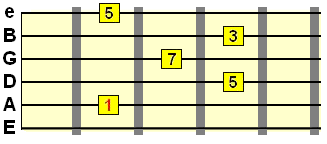
Major 7th chords are abbreviated with a "maj7" (e.g. Amaj7, Bmaj7, Cmaj7 etc.). So, if you see a chord written like this, you'll know what it is!
This means whichever scale we choose to play over a major 7th chord, it must either include the major 7th or not include any 7th at all. For example, the Mixolydian scale contains a flat 7th (b7), so it wouldn't be compatible with a major 7th chord.
The two most common major 7th scales are the major/Ionian scale...
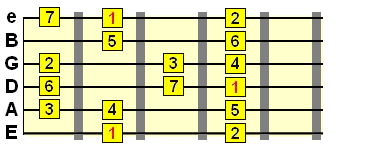
Tip: Use the 4th wisely over maj7 chords as it can sound dissonant when held. The 4th is most commonly used as a passing tone over these chords, glancing over it and/or resolving to the 3rd.
...and the Lydian scale...
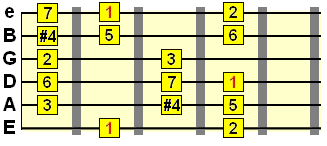
And because the major pentatonic scale doesn't include any 7th, it'll be compatible with maj7 chords, as there's nothing to clash with that major 7th tone...
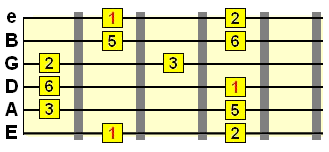
Try any of these scales over the major 7th backing track below to get an ear for their unique flavour. It's in the key of C# major, which means the root note of both the chord and any scale you use will be C#.
Download the C#maj7 backing track here (right click and "save as")
Dominant 7th chords are made up of the major triad (R, 3, 5) and a flat 7th (b7), sometimes called a minor 7th (although to avoid confusion with a chord we'll be looking at later, I just call it a flat 7th).
A dominant 7th chord would be abbreviated simply with a 7 (e.g. A7, B7, C7 etc.)
A few of examples of dominant 7th chord forms...
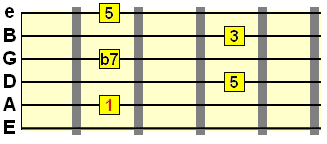
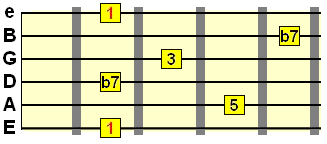
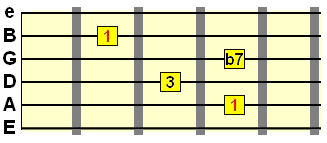
You can hopefully make an informed guess at what we're looking for in a scale to solo over dominant 7th chords...
That's right, we're looking for scales with a b7! Scales that complement the dominant 7th flavour.
For example, we could use Mixolydian...
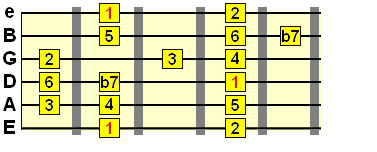
Or something a bit more tense such as Lydian dominant...
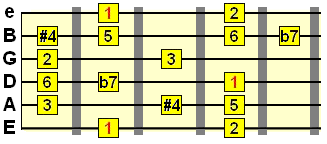
Or Phrygian dominant...
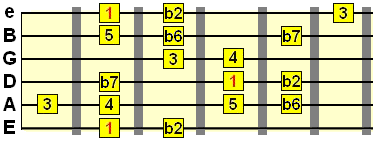
Notice how the names of some of these scales suggest they are natural dominant 7th scales. In music theory, the word dominant relates to this flat 7th tone.
We could also use major pentatonic because, again, it doesn't include any 7th so is effectively "7th neutral".
In a nutshell, when you solo over 7th chords, you should avoid playing the major 7th over dominant 7th chords!
Try out these scales over the dom7 backing track below. This time we're in the key of Bb (B flat) major, meaning our chord and scale root note is Bb.
Download the Bb7 backing track here (right click and "save as")
Minor 7th chords are abbreviated as "m7" (e.g. Am7, Bm7, Cm7 etc.).
Some common minor 7th chord forms...
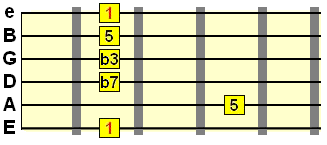
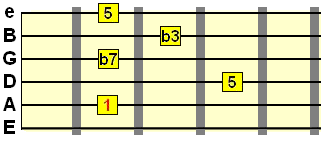
Let's look at some flat 7th minor scale examples...
Natural minor...
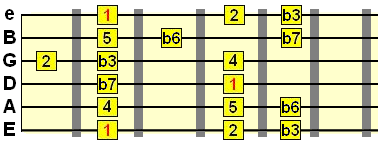
Dorian...
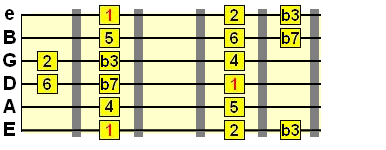
Dorian #4 (this is just Dorian with a sharp 4th tone)...
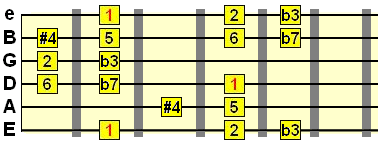
And minor pentatonic...
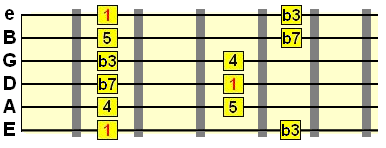
Have a jam over the m7 backing track below, using any of the scales above. We're in the key of D minor, so the root note will of course be... D.
Download the Dm7 backing track here (right click and "save as")
Minor major 7th chords are abreviated as "mM7", the capitalised M representing the major 7th (so AmM7, BmM7, CmM7 etc.)
Play the following chord forms in any position on the fretboard to get a feel for this wonderful chord...
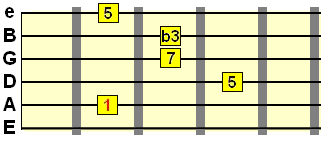
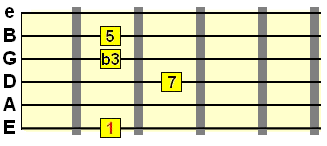
As for choosing scales, we'll need a minor scale which uses the major 7th. The two scales associated with this sound are harmonic minor...
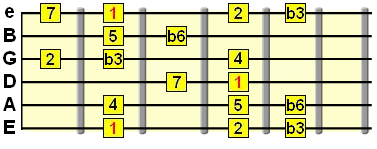
...and melodic minor...
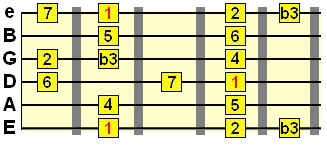
So, here we are again! Explore these scales over the mM7 backing track below. Listen to how the major 7th enhances the overall feel of the music.
We're in the key of Eb (E flat) for this, meaning our root note will be Eb.
Download the EbmM7 backing track here (right click and "save as")
I hope you found this lesson easy to understand and I'll see you in the next part, when you're ready!
Soloing Over Extended Chords
Learn Guitar Scales
Guitar Theory Lessons
How to Solo Over 7th Chords
In the last part we looked at how to pick the right scales and tones for soloing over major, minor and suspended chords. Make sure you've been through that lesson before you move on!

|
The chord theory series looks at what 7th chords are made of, so it'll help to understand these building blocks, but I'll reference examples throughout this lesson.
Also, the more scales you learn, the better (see the scales section), because you'll know exactly which type of 7th each scale uses. Again, I'll reference examples.
Soloing over major 7th chords
Major 7th chords consist of the major triad: root (1), 3rd (3) and 5th (5) plus an extra tone - the major 7th (7). They have a distinct sound, often described as "dreamy" that you should train your ear to identify. Here are two of the most common major 7th chord forms. Play them in various positions up the fretboard to get to know its sound in any key...

Major 7th chords are abbreviated with a "maj7" (e.g. Amaj7, Bmaj7, Cmaj7 etc.). So, if you see a chord written like this, you'll know what it is!
This means whichever scale we choose to play over a major 7th chord, it must either include the major 7th or not include any 7th at all. For example, the Mixolydian scale contains a flat 7th (b7), so it wouldn't be compatible with a major 7th chord.
The two most common major 7th scales are the major/Ionian scale...

Tip: Use the 4th wisely over maj7 chords as it can sound dissonant when held. The 4th is most commonly used as a passing tone over these chords, glancing over it and/or resolving to the 3rd.
...and the Lydian scale...

And because the major pentatonic scale doesn't include any 7th, it'll be compatible with maj7 chords, as there's nothing to clash with that major 7th tone...

Try any of these scales over the major 7th backing track below to get an ear for their unique flavour. It's in the key of C# major, which means the root note of both the chord and any scale you use will be C#.
Download the C#maj7 backing track here (right click and "save as")
Soloing over dominant 7th chords
Go more in depth with dominant seventh harmony here.Dominant 7th chords are made up of the major triad (R, 3, 5) and a flat 7th (b7), sometimes called a minor 7th (although to avoid confusion with a chord we'll be looking at later, I just call it a flat 7th).
A dominant 7th chord would be abbreviated simply with a 7 (e.g. A7, B7, C7 etc.)
A few of examples of dominant 7th chord forms...



You can hopefully make an informed guess at what we're looking for in a scale to solo over dominant 7th chords...
That's right, we're looking for scales with a b7! Scales that complement the dominant 7th flavour.
For example, we could use Mixolydian...

Or something a bit more tense such as Lydian dominant...

Or Phrygian dominant...

Notice how the names of some of these scales suggest they are natural dominant 7th scales. In music theory, the word dominant relates to this flat 7th tone.
We could also use major pentatonic because, again, it doesn't include any 7th so is effectively "7th neutral".
In a nutshell, when you solo over 7th chords, you should avoid playing the major 7th over dominant 7th chords!
Try out these scales over the dom7 backing track below. This time we're in the key of Bb (B flat) major, meaning our chord and scale root note is Bb.
Download the Bb7 backing track here (right click and "save as")
Soloing over minor 7th chords
As the name suggests, minor 7th chords consist of the minor triad: Root (1), minor 3rd (b3) and 5th (5) plus an extra tone, the flat 7th (b7). In a minor context we can also call this flat 7th a minor 7th.Minor 7th chords are abbreviated as "m7" (e.g. Am7, Bm7, Cm7 etc.).
Some common minor 7th chord forms...


Let's look at some flat 7th minor scale examples...
Natural minor...

Dorian...

Dorian #4 (this is just Dorian with a sharp 4th tone)...

And minor pentatonic...

Have a jam over the m7 backing track below, using any of the scales above. We're in the key of D minor, so the root note will of course be... D.
Download the Dm7 backing track here (right click and "save as")
Soloing over minor major 7th chords
The term "minor major 7th" might sound conflicting, but all it means is a minor triad (R, b3, 5) with a major 7th (7) as opposed to the minor 7th (b7) more naturally associated with minor chords. This results in a very unusual, harmonically tense sound.Minor major 7th chords are abreviated as "mM7", the capitalised M representing the major 7th (so AmM7, BmM7, CmM7 etc.)
Play the following chord forms in any position on the fretboard to get a feel for this wonderful chord...


As for choosing scales, we'll need a minor scale which uses the major 7th. The two scales associated with this sound are harmonic minor...

...and melodic minor...

So, here we are again! Explore these scales over the mM7 backing track below. Listen to how the major 7th enhances the overall feel of the music.
We're in the key of Eb (E flat) for this, meaning our root note will be Eb.
Download the EbmM7 backing track here (right click and "save as")
I hope you found this lesson easy to understand and I'll see you in the next part, when you're ready!
| |
Tweet |
 Like This?
Subscribe & Learn More... Like This?
Subscribe & Learn More...Subscribe to the fretjam newsletter below for updates and extras, plus grab your free copy of Uncommon Chords: 101 Vibrant Voicings You Won't Find on a Typical Chord Chart. |
Related
Soloing Over Extended Chords
Learn Guitar Scales
Guitar Theory Lessons








